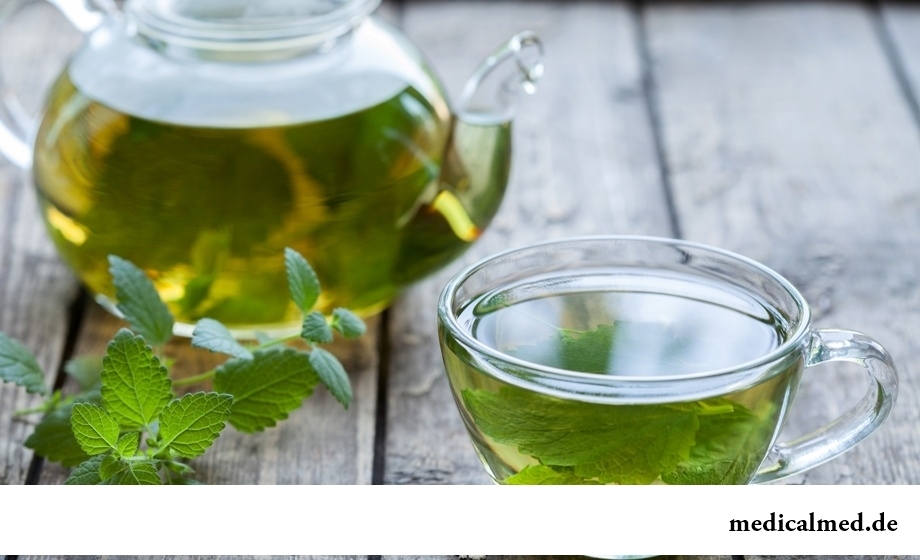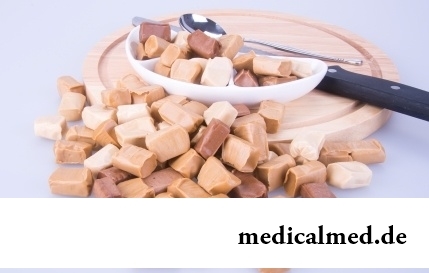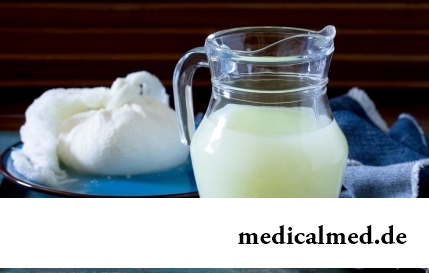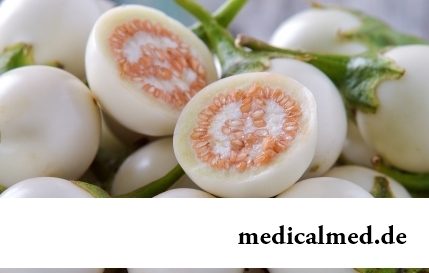





Melissa
Description of a melissa
Melissa medicinal – the perennial herbaceous essential oil-bearing plant of family of Yasnotkov reaching up to one meter in height. It treats the most popular aromatic and medicinal plants known to mankind throughout centuries. More than two thousand years ago it grew up in Ancient Rome and added to food for arousing appetite.

Plant rhizome branchy, and a stalk – silnorazvetvlenny with slightly trimmed top. At a melissa ovoid, roundish leaves of dark green color from the upper party and lighter from below. The melissa in June-August the small white or pink flowers collected in bosoms of upper leaves blossoms.
The melissa is distinguished by the strong lemon smell especially pleasant before blossoming which is given it by essential oils. Exactly thanks to a smell the melissa is used as culinary seasoning along with such plants as a sage, a peppermint, a marjoram and rosemary. The lemon smell attracts bees, why a plant and received the Latin name – "A bee star".
East Mediterranean is considered the homeland of a melissa, now it is cultivated practically worldwide.
Structure of a melissa
The melissa has a set of useful properties which are defined being its part:
- Essential oils (from 0,1 to 0,3%) from more than two hundred various connections, the most characteristic of which are geraniol, citral, citronellol, nerol and rhodinal;
- Flavonoids, among which космосиин, апигенин, цинарозид, isoquercitrin, рамноцитрин and лютеолин;
- Tannins;
- Fenilpropanoidami;
- Monoterpenes;
- Macro - and microelements among which there is a potassium, calcium, manganese, magnesium, iron, zinc, copper, selenium, chrome, vanadium, molybdenum, nickel;
- Fenolkarbonovy acids.
Medical use and useful properties of a melissa
Thanks to the medicinal properties the melissa is applied long since in traditional medicine of the different countries.
In the Arab countries the melissa was used at treatment of sincere diseases, epilepsy, apathy, an apoplexy and melancholy. Also it was parts of various "elixirs of life".
One of the known useful properties of a melissa is its calming action. It is applied in case of complaints at pregnancy, at disturbances of periods and hysterics which are inherent generally to women.
As the soothing, spasmolytic and calming a nervous system means a melissa is applied in traditional medicine of Bulgaria. Folk healers of this country, thanks to medicinal properties of a melissa, apply it:
- At treatment of migraine, nervous weakness, sleeplessness, skin rash;
- For arousing appetite;
- As an antiemetic;
- For simplification of gripes which are caused by a delay of gases;
- For poultices and compresses at treatment of furuncles.
The French scientists investigating useful properties of a melissa revealed that the plant possesses calming, anti-spasmodic, strengthening a cardiac muscle and stimulating the central nervous system with properties.
In Poland the melissa is, as a rule, applied as a valerian root analog as sedative.
In the countries of Central Asia broth of leaves is used as diuretic, and also at stomach aches, digestion disturbance, gout and an anemia.
Avicenna, describing medicinal properties of a melissa in "A canon of medical science", wrote that she "helps at obstruction of a brain, invigorates and strengthens heart and eliminates a fetor from a mouth". Often the melissa is appointed as additional therapy for strengthening of a cardiac muscle and at tachycardia attacks.
Infusion from leaves and flowers of a melissa is accepted at an asthma, bad digestion, asthma, sleeplessness, various neuralgia, painful periods, an anemia and also as sudorific and a purgative.
Melissa treats the few plants which children can apply at treatment of arterial hypertension, a diabetes mellitus, cholecystitises, pyelonephritises, children's neurosises, obesity and rheumatism.
The traditional medicine also uses medicinal properties of a melissa. The set of means in the form of aromatic waters, medicinal teas and broths, and also the medicines containing a melissa is issued (for example, Persen, New Passitum, Nervofluks).
Use of a melissa in cookery
Thanks to the gentle refreshing taste and lemon aroma the melissa is widely used as spice for preparation of many dishes. Fresh leaves of a melissa add, having small cut, in salads. Dried leaves of a melissa can be added together with other herbs to meat, vegetable, mushroom and fish dishes. It is organically combined with the dishes containing lemon juice.
As spice a melissa is often applied in house conservation at a pickles of vegetables (tomatoes and cucumbers).

Melissa – an irreplaceable component of various drinks. The dried-up leaves are made as tea, flavor them house kvass, and also added to compotes. Fresh leaves improve taste of a domestic wine and beer.
At use of a melissa as spice should consider that it quickly loses the aroma therefore it is recommended to be added in several minutes until the end of preparation or to strew with it already ready dishes.
Contraindications
Melissa, as well as the drugs containing this plant it is not recommended to apply at individual intolerance and at arterial hypotension.
In our intestines are born, millions of bacteria live and die. They can be seen only at strong increase, but if they gathered, then would be located in a usual coffee cup.

Food with the increased content of sugar is attractive to most of people - it is scientifically confirmed fact. Business here not in a nevozder...
Section: Articles about health
Sugar - the digestible refined product which is not of special value for an organism of the modern person. The use of sugar in food is based rather on the psychological dependence caused by desire to indulge itself with something tasty, and in дальнейш...
Section: Articles about health
The stroke is one of the most widespread diseases of the person, annually in the world about 6 million cases of this pathology are registered. According to medical statistics, strokes occur almost three times more often than myocardial infarctions. The disease belongs to heavy, and has an unfavourable result: the lethality reaches 40% among women and 25% among men. A considerable part of the patients who endured a stroke cannot be recovered completely. We suggest readers to examine...
Section: Articles about health
Stability of a hormonal background is one of the most important conditions of preservation of health of the woman. At the same time endocrine system –...
Section: Articles about health
Dietary supplements (dietary supplements) for the last decades were so thoroughly included into our life that, apparently, it is already impossible to find the person who at least once did not try them. At the same time, most of our compatriots have a vague idea about...
Section: Articles about health
For anybody not a secret that our country is one of the most "drinking" in the world. At clear understanding that the use of hard alcoholic drinks – occupation extremely harmful, most of Russians belong to alcoholism with unjustified loyalty. Apparently, existence of a set of myths in which tendency to excessive libations looks nearly positively is explained by it. It is worth getting acquainted with the most widespread of similar delusions and to be convinced in them not...
Section: Articles about health
It seems, quite recently you brought the baby from maternity hospital, but time flew by, and here it is already going to join the first...
Section: Articles about health
The nature does not stand stagnation and monotony. It is known that tissues of a human body atrophy if do not receive necessary loadings. It fully belongs also to a cerebral cortex: when it is not given full-time job, it begins to function worse. In резуль...
Section: Articles about health
The business lady, the become mother, it is necessary to solve an array of problems. But of them is main: how to combine the beloved child and work? What traps trap the working mother and how she needs to behave?...
Section: Slideshow
Cold is such painful that each sigh becomes a victory, heat "knocks" down, and the ache in joints forces to think only about...
Section: Articles about health
Women quite often suffer from complexes concerning the sizes of the bust. Strangely enough, not too modest, and excessively curvy shapes become the reason of sincere discomfort sometimes. Except psychological problems, a big bust sometimes with...
Section: Articles about health
Radiological methods of a research are applied in medicine more than hundred years, and thanks to them millions of lives were saved. In many cases without X-ray it is impossible to make exact idea of a condition of bodies and fabrics, it is correct to make the diagnosis. Nevertheless, many myths about researches such continue to exist. Let's consider the most widespread of them....
Section: Articles about health
Phobia – the persuasive fear of a certain contents shown in a specific situation against the will of the person. Concepts of a phobia and fear...
Section: Articles about health
The fatigue, sleep debt, disturbances of food, bad mood, vagaries of the weather – all these circumstances badly affect our appearance. Especially the person suffers: skin becomes flabby, loses healthy color, becomes covered by wrinkles, zones of hypostases and t appear...
Section: Articles about health
It would seem, to buy drugs in Moscow does not make a problem – a drugstore, and not one, is available for each resident of the capital within walking distance. And, nevertheless, Internet drugstores become more popular – what it is possible to explain such phenomenon with? Actually there is a lot of reasons and if to formulate them it is short, then the most suitable word will be - "conveniently". We suggest to get acquainted in more detail with pluses and minuses of online drugstores that buying drugs, not to make the wrong choice....
Section: Articles about health
Any of us is not insured from a heavy illness of the loved one. Happens and so that someone from family members becomes lying бо...
Section: Articles about health
Practically each person is familiar with the annoying, pulling, unscrewing pains caused by overcooling of muscles of a back. In certain cases inflammatory process is not limited to discomfort, being followed by emergence of hypostasis, consolidations, increase температ...
Section: Articles about health
On health of the person physicians know about salutary action of animals long ago. About 7 thousand years ago great Hippocrates recommended to the patients riding walks for strengthening of a nervous system and increase in vitality....
Section: Articles about health
Milk and products of its processing by right occupy one of the main places in a diet of the modern person. They contain necessary...
Section: Articles about health
The problem of diagnosis was and remains to one of the most important in medicine. From that, the reason of an indisposition of the patient will be how precisely defined, eventually success of treatment depends. In spite of the fact that the majority of the diagnostic methods applied in about...
Section: Articles about health
Each of us repeatedly noticed that the people having the same passport age are sometimes not similar on one-years at all. One at the age of 40-45 years already looks almost an old man, and another and in 60 is young, vigorous and full of life. The matter is that the condition of our health depends not on the number of the lived years, and on degree of safety of an organism. This factor also defines biological age of the person....
Section: Articles about health
It is possible to find the extensive range of fruit and vegetables in modern shops. Russians already got used that on counters in any...
Section: Articles about health
The winter swimming in open reservoirs called in our country by "winter swimming" – officially recognized sport and one of the most extreme ways of a hardening of an organism. This occupation has an old story and adherents in many countries. Are annually carried out...
Section: Articles about health
White teeth and the Hollywood smile – a dream of many people. Long time was considered that the plaque on teeth and change of their color – destiny of those who incorrectly eat smokes and badly brushes teeth. But the paradox is available: at everything the variety of toothpastes, brushes existing today for toothbrushing and conditioners for a mouth the number of the people hesitating of a plaque on teeth does not decrease. Moreover, the plaque is formed even at small children who definitely do not smoke and have no coffee. So in what business, and опас...
Section: Articles about health
The phenomenon of improvement of a condition of the patients at administration of drugs who are not containing active agents, so-called effect of placebo is known...
Section: Articles about health
Tick-borne encephalitis – one of the most dangerous viral diseases which causative agents transfer and is given to people by ixodic mites. These are the small blood-sicking insects living in the considerable territory of our country. The person bitten by a tick can catch...
Section: Articles about health
Energy saving lamps are one of the most popular products of innovative technologies, and there is no wonder: they much more economic also are more long-lasting than usual filament lamps. At the same time there are fears that energy saving bulbs can become the reason of emergence of problems with health. Unfortunately, some of similar opinions have the real reasons....
Section: Articles about health
